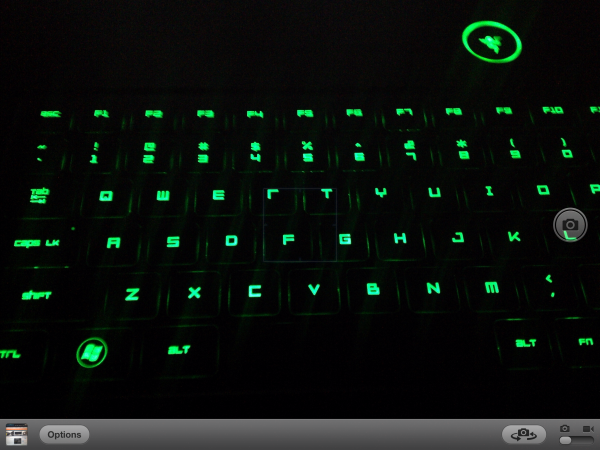The Apple iPad Review (2012)
by Vivek Gowri & Anand Lal Shimpi on March 28, 2012 3:14 PM ESTThe Camera, It's Much Improved
by Vivek Gowri
iOS 5.1 brought with it a number of bugfixes along with a few minor changes to the core entertainment applications (Music, Photos, Videos), but the only real UI change it brought was the redesigned camera application for the iPad. It fixes our biggest complaint with the original—the shutter button’s location in the middle of the settings bar at the bottom of the screen—and ends up being a big improvement from a usability standpoint. The shutter now resides in a floating circular button on the right side of the display, right where your right thumb falls when holding the iPad with two hands. It’s a more intuitive location for the shutter, so taking a picture is a far more natural feeling exercise than it was before. Other than that, the app looks pretty similar—the settings bar now has the still/video slider, front/rear camera switch, an options button, and the link to the photo gallery.
In terms of camera options, there’s only one. You can either have the rule of thirds grid overlay visible or hidden....and that’s it. There’s no other settings for you to change. No exposure, white balance, ISO, shutter speed, or anything else that isn’t the shutter button. Unfortunately, even the HDR mode from the 4 and 4S is nowhere to be found on the iPad. You literally just point and shoot. That’s all there is for you to do.
In our review of the iPad 2, we summed up the cameras with just one word, mediocre. Looking back, I realize now that the word mediocre is a pretty charitable way to describe the iPad 2’s camera situation. Both sensors were borrowed from the iPod touch, and while the VGA front facing camera was acceptable, the rear facing 720p camera was legitimately bad by the standards of a $499 device.
The new iPad fixes that rear camera problem in a big way, with the five element f/2.4 lens and optics borrowed from the iPhone 4S paired with the Omnivision OV5650 CMOS image sensor from the iPhone 4. A quick refresher on specs: 5 megapixels, backside illuminated, 1080p video at 60fps. If you ignore megapixel count, it’s a pretty competitive camera on paper. There’s a lot of recycled parts here, with bits and pieces from other iDevices frankensteined together to come up with a new imaging system for the iPad, but parts-bin raids aren’t bad when the bins being raided from contain top-tier components. The result ends up being pretty good—as a camera, the new iPad is light years ahead of its predecessor in basically every way.
In practice, it’s nothing short of stellar. Image quality is comparable to most high end smartphones, though not quite good enough to be on par with the bleeding edge cameraphones (4S, Nokia N8/N9, HTC Amaze 4G, Galaxy S 2, etc). Interestingly enough, the preview image looks to be running below 30 fps, appearing a little bit choppy at times. This is likely due to the high resolution of the preview and upscaling it to a very high display resolution, but it doesn’t particularly affect image capture. I measured shot to shot time at exactly one second (I had a range between 0.98 and 1.04 seconds, averaged out to 1.0 when factoring in reaction time). That’s about double what Apple claimed for the 4S, and a bit longer than the iPad 2. Granted, the iPad 2’s camera was very quick in part because the amount of processing it takes to capture a 960x720 image is almost zero, with about 13.8% as many pixels as each 2592x1936 image captured by the new iPad.
The focal length is 4.28mm, a bit longer than the iPad 2’s 3.85mm. The difference is actually noticeable; when taking pictures of nearby subjects, you’re sometimes surprised by how magnified the subject appears. However, the camera is good for landscapes, as you can see from the sample gallery. I took the iPad with me on a weekend trip to Victoria, B.C. and used it as my primary camera on the trip. Now, while I wouldn’t trade my SLR for an iPad anytime soon, I can’t deny that the results turned out pretty well. Colours were vibrant, white balance was accurate, and the clouds were nicely highlighted. It’s a quantum leap from the noisy, 0.7MP mess that was the iPad 2 camera. Mouse over the links below to see some comparisons between the cameras on the iPad 2, 3rd gen iPad and TF Prime.

| Apple iPad 2 | Apple iPad (3rd gen) | ASUS TF Prime |
| original | original | original |

| Apple iPad 2 | Apple iPad (3rd gen) | ASUS TF Prime |
| original | original | original |
The new sensor can record 1080p video, up from 720p. Video quality was probably the best aspect of the iPad 2 camera, and it's even better here. Output is recorded at 29.970 fps and encoded in h.264 Baseline with a bitrate of 21Mbps and single channel audio at 64kbps. The recorded video impresses, with crisp detailing and adequate audio quality from the single mic.
The front facing camera keeps the Omnivision OV297AA sensor from the iPad 2, and as such, image and video quality remain unchanged. It’s not necessarily a bad thing, since it remains adequate for FaceTime and Skype, but it would have been nice to see an update to an HD-quality webcam up front.
With augmented reality apps, I’m starting to see the benefit of rear cameras on tablets. For example, the Yelp app, which takes location and compass data to display what restaurants are the direction the iPad is pointing, with a real-time street view of the search results. It’s not necessarily the most useful way to use the rear facing camera in an AR application, but overall it’s an idea that has potential. Apple also tells us that its business and education customers see usefulness in the iPad's rear facing camera as they can use it to quickly document something while using the iPad as a productivity tool. As a consumer, you’re going to get weird looks if you’re using the iPad to take pictures though, it’s a relatively comical sight.
And that’s really the problem: from an ergonomic standpoint, smartphones are just so much easier and more comfortable to use as cameras. And because the imaging hardware is so similar, I’m not sure I see the real benefit of having a rear facing camera on a tablet except in very specific use cases.

























234 Comments
View All Comments
doobydoo - Saturday, March 31, 2012 - link
Lucian Armasu, you talk the most complete nonsense of anyone I've ever seen on here.The performance is not worse, by any stretch of the imagination, and lets remember that the iPad 2 runs rings around the Android competition graphically anyway. If you want to run the same game at the same resolution, which wont look worse, at all (it would look exactly the same) it will run at 2x the FPS or more (up-scaled). Alternatively, for games for which it is beneficial, you can quadruple the quality and still run the game at perfectly acceptable FPS, since the game will be specifically designed to run on that device. Attempting anything like that quality on any other tablet is not only impossible by virtue of their inferior screens, they don't have the necessary GPU either.
In other words, you EITHER have a massive improvement in quality, or a massive improvement in performance, over a device (iPad 2) which was still the fastest performing GPU tablet even a year after it came out. The game developers get to make this decision - so they just got 2 great new options on a clearly much more powerful device. To describe that as not worth an upgrade is quite frankly ludicrous, you have zero credibility from here on in.
thejoelhansen - Wednesday, March 28, 2012 - link
Hey Anand,First of all - thank you so much for the quality reviews and benchmarks. You've helped me build a number of servers and gaming rigs. :)
Secondly, I'm not sure I know what you mean when you state that "Prioritizing GPU performance over a CPU upgrade is nothing new for Apple..." (Page 11).
The only time I can remember Apple doing so is when keeping the 13" Macbook/ MBPs on C2Ds w/ Nvidia until eventually relying on Intel's (still) anemic "HD" graphics... Is that what you're referring to?
I seem to remember Apple constantly ignoring the GPU in favor of CPU upgrades, other than that one scenario... Could be mistaken. ;)
And again - thanks for the great reviews! :)
AnnonymousCoward - Wednesday, March 28, 2012 - link
"Retina Display" is a stupid name. Retinas sense light, which the display doesn't do.xype - Thursday, March 29, 2012 - link
GeForce is a stupid name, as the video cards don’t have anything to do with influencing the gravitational acceleration of an object or anything close to that.Retina Display sounds fancy and is lightyears ahead of "QXGA IPS TFT Panel" when talking about it. :P
Sabresiberian - Thursday, March 29, 2012 - link
While I agree that "Retina Display" is a cool enough sounding name, and that's pretty much all you need for a product, unless it's totally misleading, it's not an original use of the phrase. The term has been used in various science fiction stories and tends to mean a display device that projects an image directly onto the retina.I always thought of "GeForce" as being an artist's licensed reference to the cards being a Force in Graphics, so the name had a certain logic behind it.
;)
seapeople - Tuesday, April 3, 2012 - link
Wait, so "Retina Display" gets you in a tizzy but "GeForce" makes perfect sense to you? You must have interesting interactions in everyday life.ThreeDee912 - Thursday, March 29, 2012 - link
It's basically the same concept with Gorilla Glass or UltraSharp displays. It obviously doesn't mean that Corning makes glass out of gorillas, or that Dell will cut your eyes out and put them on display. It's just a marketing name.SR81 - Saturday, March 31, 2012 - link
Funny I always believed the "Ge" was short for geometry. Whatever the case you can blame the name on the fans who came up with it.tipoo - Thursday, March 29, 2012 - link
iPad is a stupid name. Pads collect blood from...Well, never mind. But since when are names always literal?doobydoo - Saturday, March 31, 2012 - link
What would you call a display which had been optimised for use by retinas?Retina display.
They aren't saying the display IS a retina, they are saying it is designed with retinas in mind.
The scientific point is very clear and as such I don't think the name is misleading at all. The point is the device has sufficient PPI at typical viewing distance that a person with typical eyesight wont be able to discern the individual pixels.
As it happens, strictly speaking, the retina itself is capable of discerning more pixels at typical viewing distance than the PPI of the new iPad, but the other elements of the human eye introduce loss in the quality of the image which is then ultimately sent on to the brain. While scientifically this is a distinction, to end consumers it is a distinction without a difference, so the name makes sense in my opinion.